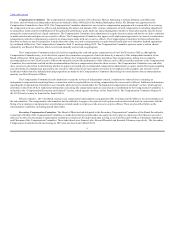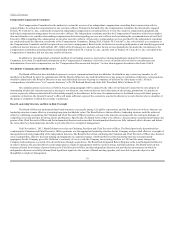Juno 2015 Annual Report Download - page 20
Download and view the complete annual report
Please find page 20 of the 2015 Juno annual report below. You can navigate through the pages in the report by either clicking on the pages listed below, or by using the keyword search tool below to find specific information within the annual report.
Table of Contents
Accordingly, adjusted operating income is our operating income before depreciation, amortization, stock-based compensation, restructuring and other exit
costs, litigation or dispute settlement charges or gains, and any impairment charges for goodwill, intangible assets and long-lived assets, and without taking
into account transaction-related expenses and expenses associated with the relocation of our principal offices or those of our subsidiaries. In addition, the
following items, to the extent applicable, were specifically excluded in calculating adjusted operating income: (i) any bonus amounts accrued under the
2015 Bonus Plan, (ii) any adjustments attributable to a change in accounting principles, and (iii) all items of gain, loss or expense determined to be
extraordinary or unusual in nature or infrequent in occurrence, or related to the disposal of a business segment or unit. The 2015 Bonus Plan furthermore
provided that the final revenue and/or adjusted operating income calculations were also to be adjusted to reflect the effect of certain foreign currency
exchange rates. In addition, the financial performance of any companies or businesses acquired during 2015 was not to be taken into account. In the event of
a sale or spin-off transaction, for the purpose of determining the revenue and adjusted operating income performance of the combined businesses for 2015,
the actual financial performance of the divested business would be taken into account for the portion of 2015 preceding the closing of such transaction, and
target-level performance by the divested business would be taken into account for the post-closing portion of the year.
Under the 2015 Bonus Plan, for each specified level of attainment, a specific cash bonus amount was individually allocated to the participant based
on a certain percentage of his or her annual rate of base salary. For 2015 Bonus Plan participants, the financial metric attained (for purposes of the financial
performance goals) had to exceed the threshold level in order to earn a bonus amount. If there was only threshold attainment of the applicable revenue goal or
adjusted operating income goal, then no bonus amount would have been paid with respect to that financial metric. However, in that circumstance, all
participants would still be eligible for a bonus based on their respective individual performance goals.
The Compensation Committee determined the various levels of potential financial goal attainment based on its assessment of the financial
objectives set forth in our confidential, internal operating budget for 2015. Those levels reflect the Compensation Committee’s assessment as to the minimum
amount that would have to be achieved by the combined businesses in order for the executive officer to earn an incentive award, and the maximum level of
goal attainment at which the executive officer’s bonus potential would be capped. In addition, participants would not earn a bonus (for purposes of the
financial performance goals) if only a threshold level of financial performance was achieved.
The named executive officers who were selected for participation in the 2015 Management Bonus Plan were as follows: Mr. Lobo, Mr. Zinser and
Ms. Tsuda. Mr. Harrington commenced employment with us in August 2015 and was not a direct participant in the 2015 Bonus Plan; however, his bonus (for
2015) was calculated as if he participated in the 2015 Bonus Plan.
The potential bonus amounts per participant ranged from 0% to 151.3% of base salary for Mr. Lobo (based on a target bonus of 100% of base salary),
0% to 105.9% of base salary for Mr. Zinser (based on a target bonus of 70% of base salary), 0% to 83.2% of base salary for Mr. Harrington (based on a target
bonus of 55% of base salary), and 0% to 75.6% of base salary for Ms. Tsuda (based on a target bonus of 50% of base salary). Mr. Fakiri did not participate in
the 2015 Bonus Plan in light of the fact that he was promoted in March 2015; however, for 2015, Mr. Fakiri received a discretionary bonus of $193,100.
Mr. Phanstiel did not participate in the 2015 Management Bonus Plan because he served as our Principal Executive Officer for a short period from
November 2015 to January 2016 and did not earn any compensation for such role. The Compensation Committee set the potential target bonus award for
Mr. Lobo at a higher percentage (100%) than for the other executive officers to reflect the greater impact of his duties and responsibilities upon our ability to
meet the Company’s goals.
The following tables set forth the 2015 Bonus Plan’s financial performance goals and the related potential bonus amounts (as a percentage of base
salary) each such named executive officer would have been eligible to earn if the performance goals were attained at such payout levels (which would be
interpolated for performance between such levels). The following tables also set forth the related potential bonus amounts (as a percentage of base salary) for
such participant’s individual performance goals, assuming target achievement of such performance goals. The individual performance goals consist of
multiple goals, including items such as: streamlining department operations, supporting the Company’s strategic initiatives (including potential merger and
acquisition activity) and implementing solutions (including software solutions) to improve Company efficiencies and reduce costs.
19
























